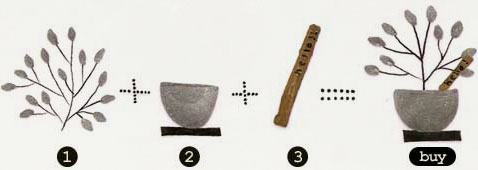
How do I take care of plants I bought?
And this goes for every plant, not just the ones that you bought from us :)
Water them regularly and provide them with adequate sunlight and enough room to grow, that's it, and you are almost all set.
Detailed instruction sets coming soon

List of herbs we offer
Oregano, Thyme, Rosemary, Chives, Lemongrass, Sage, Mint, Pepper, Basil, Bayleaf, Cinnamon, Vanilla, Geranium, Lemon balm, Aloe-vera
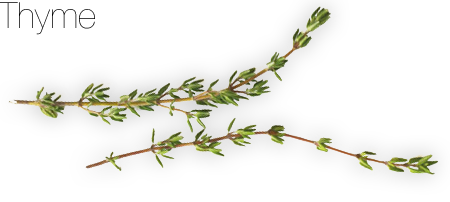
- Thyme (pronounced "time") is a fragrant, small-leafed, woody-stemmed culinary herb that is used frequently in Mediterranean, Italian and Provençal French cuisines. It pairs well with lamb, poultry and tomatoes, and is often used in soups, stews, stocks and sauces.
- Other herbs with which thyme can be successfully combined include rosemary, marjoram, parsley, oregano and bay leaf.
- Thyme is best cultivated in a hot, sunny location with well-drained soil. It is generally planted in the spring, and thereafter grows as a perennial. It can be propagated by seed, cuttings, or by dividing rooted sections of the plant. It tolerates drought well. The plants can take deep freezes and are found growing wild on mountain highlands. Along the Riviera it is found from sea level and up to 800m.
- Thyme deserves a place in all gardens. Its foliage is attractive, the long-lasting flowers are very pretty and it is a compact easy-care plant.
- On top of that it is one of the most useful herbs for the kitchen. Thyme reaches a height of 30 cm (12in) and is best suited either to the rock garden or the front of a border. Sometimes it is grown between paving stones; it is highly aromatic and when trodden on its scent is intensified.
- Where to Grow Thyme: Thyme likes a well-drained light soil, it should not be too rich in nutrients which will only make the plant 'leggy' and loose its compact shape. Being a native of the Mediterranean it needs a place in full sun.
- Thyme requires very little attention - water only in very dry conditions and feed sparingly. A good mulch with organic matter in October time will help protect them from severe frost and will also provide most of their feeding needs. If organic matter is not available, a handful of bonemeal per plant in mid-May and July will meet their needs.
- Thyme herb tea is a popular health drink.
- Thyme has been used in the preparation of season soups, and sauces.
- Thyme, along with other spicy items, has been used to marinate and stuffing to chicken, fish and meat recipes
- Just 100 g of fresh leaves provides (% of Recommended daily allowance)
- 38% of dietary fiber
- 27% of vitamin B-6 (pyridoxine)
- 266% of vitamin C
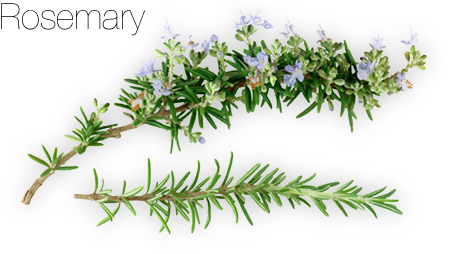
- Is a woody perennial herb with fragnant, evergreen needle like leaves and white, pink, purple or blue flowers, native to the mediterranean region.
- It is a member of the mint family Lamiaceae
- The name ' rosemary ' derives from the Latin for 'dew' (ros) and 'sea' (marinus) because in many areas it needs no water other than humidity carried by sea breeze to live.
- Rosemary is used as a decorative plant in gardens and has many culinary and medical uses. The plant is said to improve the memory. The leaves are used to flavour various foods, like stuffings and roast meats.
- Rosemary contains the antioxidants carnosic acid and rosmarinic acid, and other bioactive compounds including camphor, caffeic acid, ursolic acid, betulinic acid, rosmaridiphenol, and rosemanol. Some of these may be useful in preventing or treating cancers, strokes and Alzeihmer's disease.
- Rosemary plant care is easy. Plant is drought tolerant.
- When growing rosemary plants, provide them with well-drained, sandy soil and at least 6-8 hours of sunlight. These plants thrive in warm, humid environments and cannot take extremely cold temperatures.
- Rosemary prefers to remain somewhat on the dry side; therefore, terra cotta pots are a good choice when selecting suitable containers. These pots allow the plant to dry out faster. Thoroughly water rosemary plants when the soil is dry to the touch but allow the plants to dry out between watering intervals. Even indoors, rosemary plants will require lots of light, at least six hours, so place the plant in a suitable location free of drafts.
- Rosemary can grow quite large and retain attractiveness for many years, can be pruned into formal shapes and low hedges
- It will not withstand water logging and some varieties are susceptible to frost.
- It grows best in neutral to alkaline conditions (pH 7-7.8) with average fertility. It can be propagated from an existing plant by clipping a shoot (from a soft new growth) 10-15 cm (4-6 in) long, stripping a few leaves from the bottom, and planting it directly into soil.
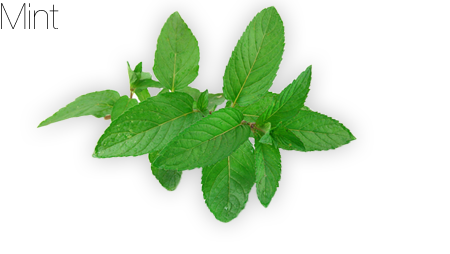
- Mint are great for beginners- easy to grow and safe to use, and a must for every herb garden.
- The herb, mint, belongs to a large family with over 30 species, the most common being peppermint and spearmint.
- Apart from peppermint, spearmint is probably the most widely used species of mint. It is not as strong as peppermint in flavour and is therefore used in cooking and added to sauces, dressings, cakes and can be added as a garnish to dishes.
- All mints contain the volatile oil menthol, which gives mint that characteristic cooling, cleansing feeling.
- Mints are aromatic, almost exclusively perennial, rarely annual, herbs. They have wide-spreading underground and overground stolons and erect, square, branched stems.
- The leaves are arranged in opposite pairs, from oblong to lanceolate, often downy, and with a serrate margin. Leaf colours range from dark green and gray-green to purple, blue, and sometimes pale yellow. The flowers are white to purple and produced in false whorls called verticillasters. The corolla is two-lipped with four sub-equal lobes, the upper lobe usually the largest. The fruit is a small, dry capsule containing one to four seeds.
- While the species that make up the Mentha genus are widely distributed and can be found in many environments, most Mentha grow best in wet environments and moist soils. Mints will grow 10-120 cm tall and can spread over an indeterminate area. Due to their tendency to spread unchecked, mints are considered invasive.
- Mint is a perennial and its seeds can be sowed in flats or in the ground. Once the tenacious herbs take hold in your garden, it is very easy to propagate them by cuttings and transplanting once the root system is well established. Mint needs humid soil and only moderate sunshine. It will grow in, out and around all garden plants, not unlike a weed, this herb is tenacious and dedicated to spreading through the garden. The trick is to continuously cut it back and restrict growth. Otherwise this herb will spread like wild fire through your garden in the form of strong willed runners. Frequently cutting or mowing of large plots will keep mints at their prettiest. In late fall, cut back to the ground and mulch if winters are severe.
- Mint can be grown in pots and planted with other herbs. And according to legend this is a good herb for keeping ants away from doors and combating mice and fleas. Keep mint leaves near food, beds and wardrobes. Use it to freshen the house like an air freshener it brings the fresh smell of herbal fragrance into every room. It can be simmered in a pot of water with Rosemarie, and lemon grass to create a unique and lively potpourri.
- The mint varieties come in a number of good and useful flavours. There is one called Chocolate mint to be used in desserts, Spearmint for drinks, Peppermint for drinks & desserts and garden mint for general cooking Pineapple mint for salads & cooking.
- To reduce the effects of tannin and caffeine in your favourite tea use fresh mint, Spearmint, or Peppermint sprigs in your teapot with your favourite tea. Snap a few well-sized leaves off, wash, and add to your teapot. Steep for 2-3 minutes. Longer for a more potent flavour.
- Many cooks like to add chopped mint leaves to scrambled eggs, and omelettes, for a change of pace, or to egg substitutes to enhance the flavour. Add the mint at the end of cooking of scrambled eggs or omelettes. Too much heat will turn the mint bitter. Fresh mint leaves are good in salads.
- Mint is commonly used with peas. Carrots, potatoes, eggplant, beans, and corn to pep up the flavour.
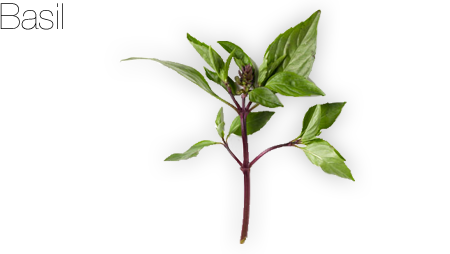
- Basil, or Sweet Basil, is a common name for the culinary herb Ocimum Basilicum
- Basil, originally from India, is a half-hardy annual plant, best known as a culinary herb prominently featured in Italian cuisine, and also plays a major role in the Northeast Asian cuisine of Taiwan and the Southeast Asian
- The word basil comes from the Greek (basileus), meaning "king", as it is believed to have grown above the spot where St. Constantine and his mother St. Helen discovered the Holy Cross.
- Basil is commonly used fresh in cooked recipes. In general, it is added at the last moment, as cooking quickly destroys the flavour.
- For the best harvest, give plants full sun, ample water, and regular pruning.
- The most common is bush or sweet basil, a compact plant growing to 18 inches or so during the season.
- Pretty purple flowers on the basil plants. Pinch them off. they are also a sign that the plant is shutting down and going into reproduction mode (instead of growth mode,they are also a sign that the plant is shutting down and going into reproduction mode (instead of growth mode ) Pinching off these flowers helps keep the plant growing.
- Pinch off the centre shoot of the basil plant after it has grown for 6 weeks to force side growth and prevent early flowering. If flower stalks do develop, cut them off.
- Harvesting : Basil is at its most pungent when fresh. The best time to harvest is just as the plant starts to bud, well before flowers bloom. Snip leaves or branches at this time and pinch off flower buds to keep the plant productive. You also can cut the entire plant about 6 to 8 inches above ground, leaving at least one node with two young shoots intact. The plant should produce a second but smaller harvest several weeks later.


